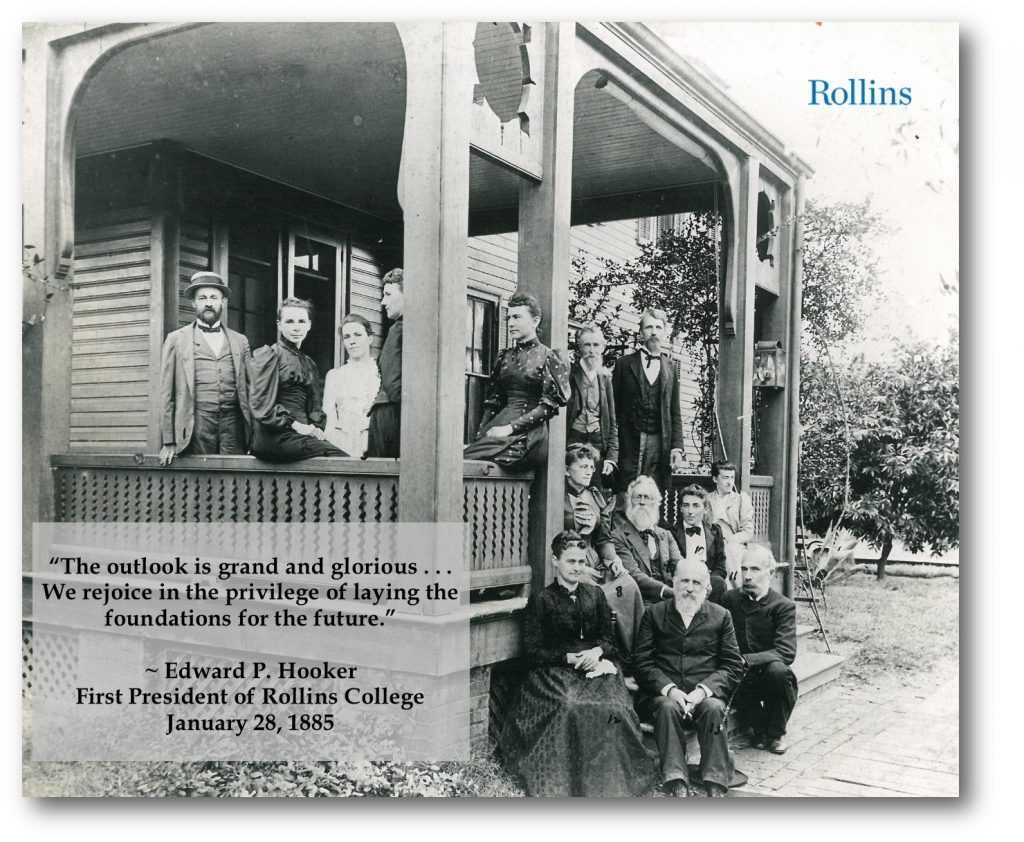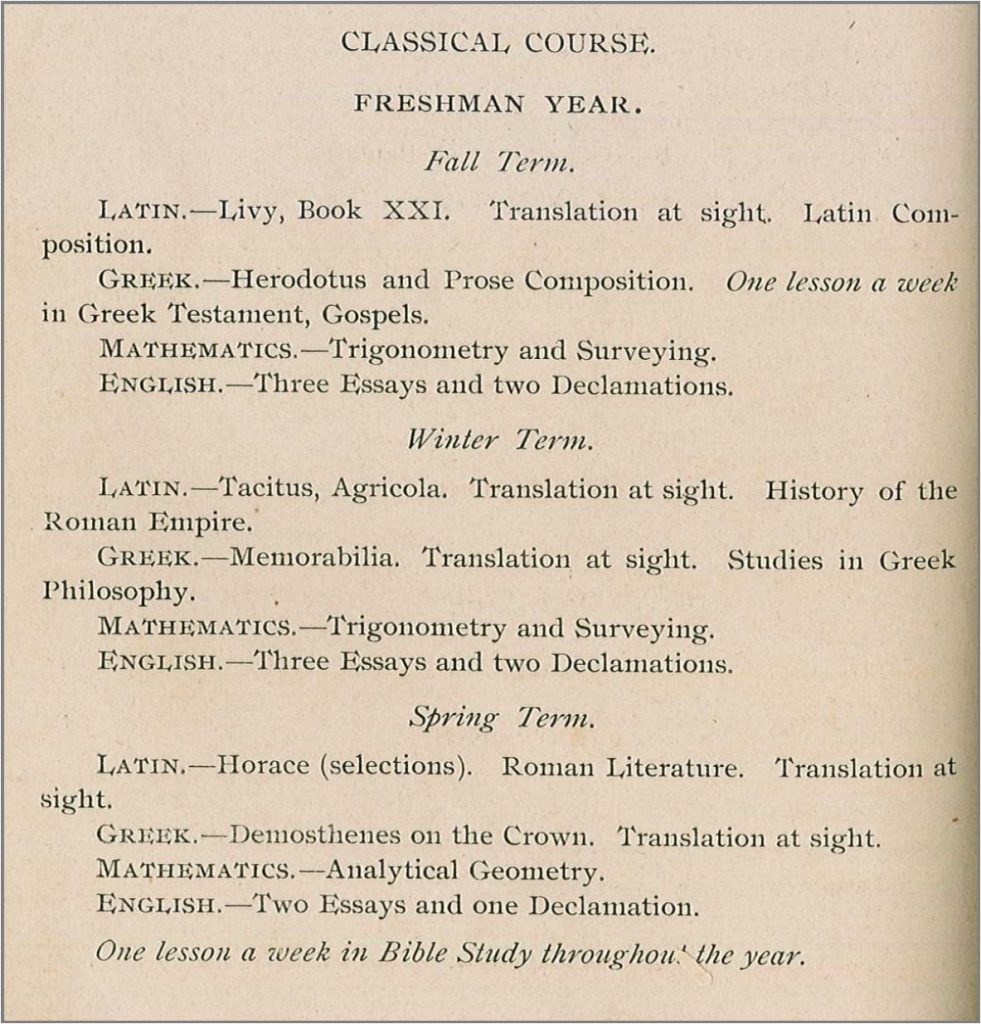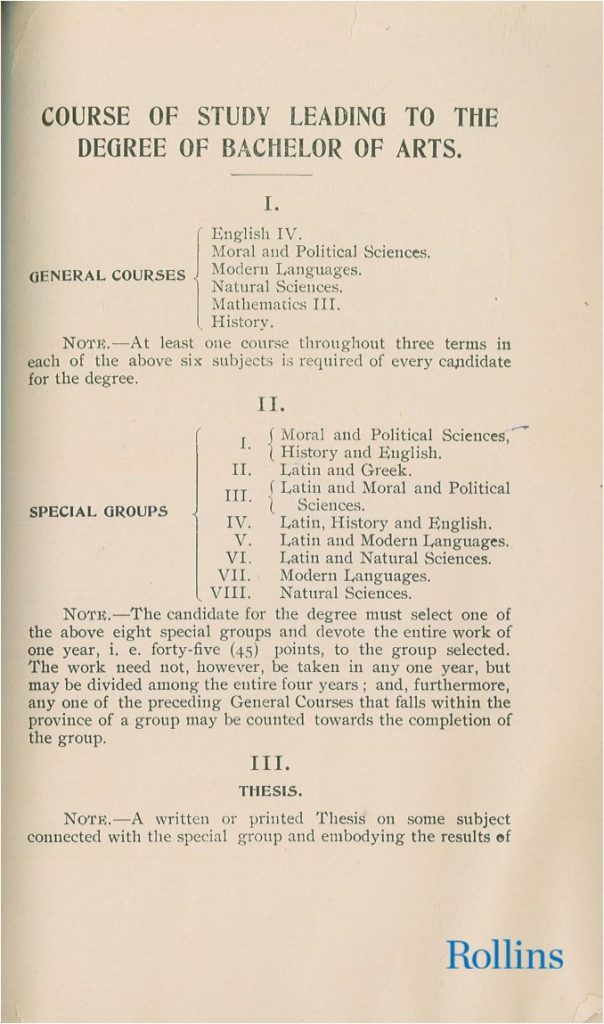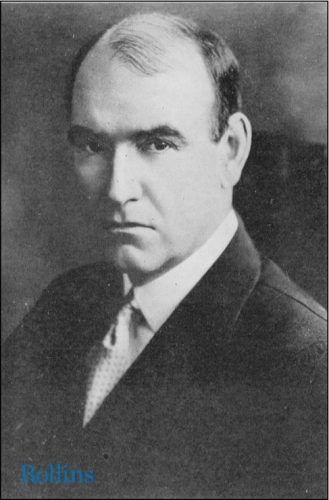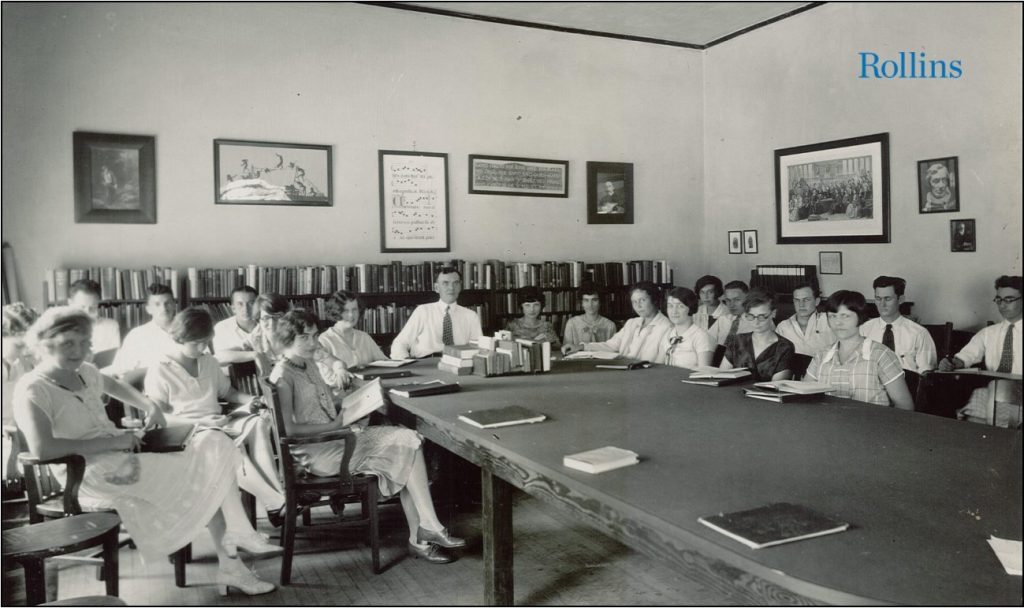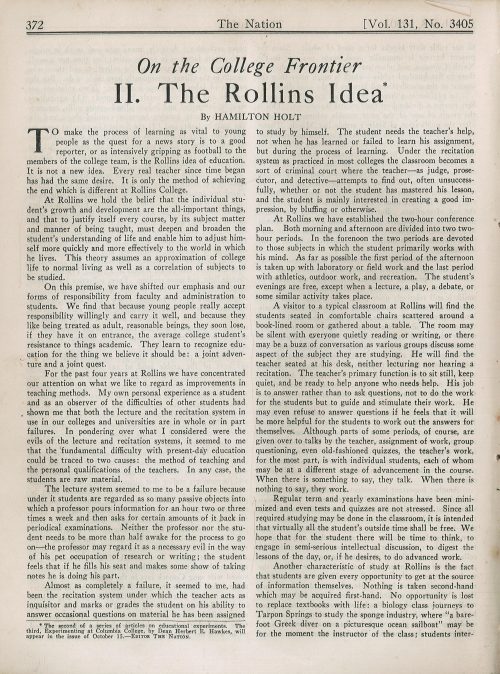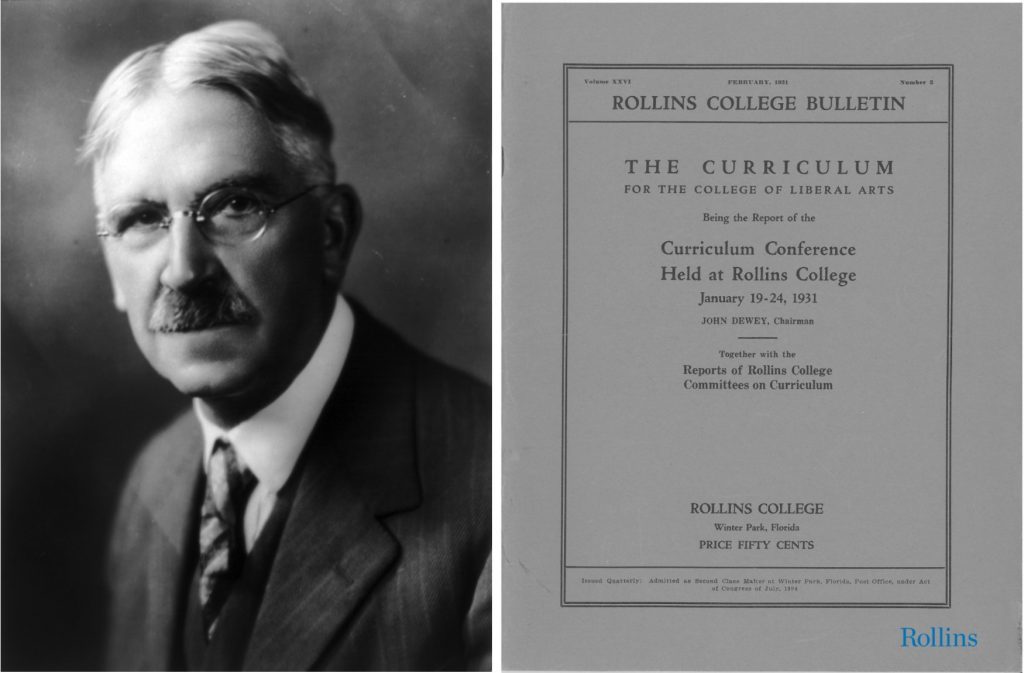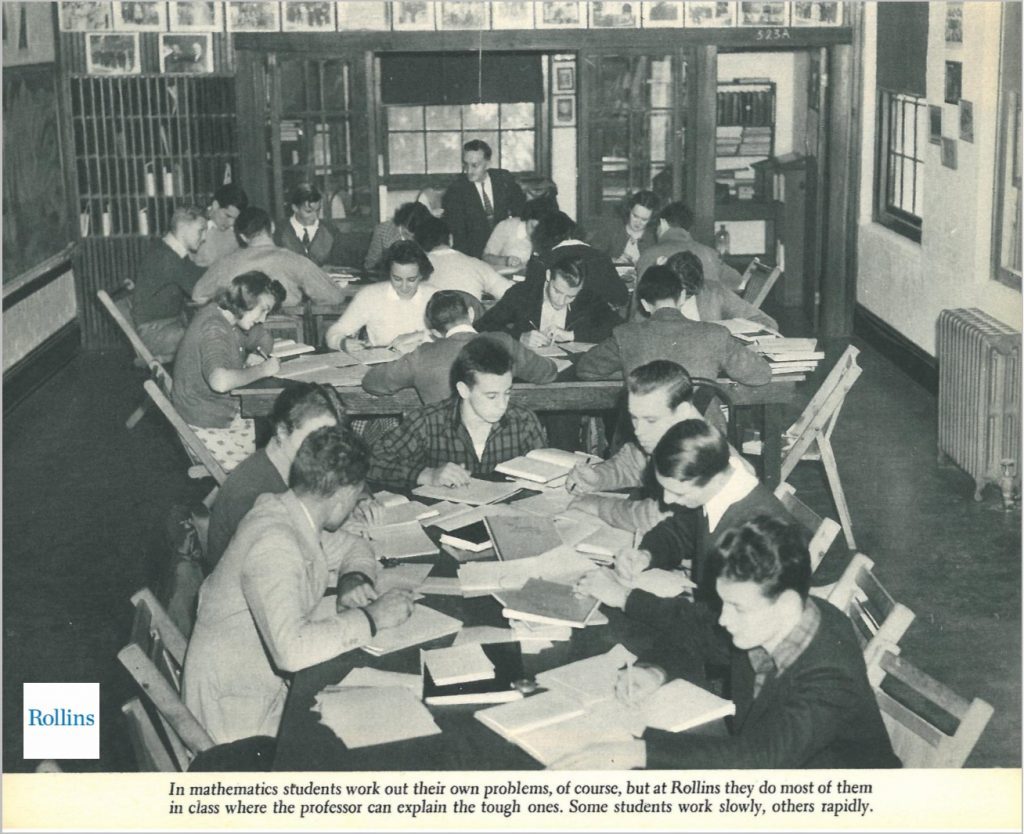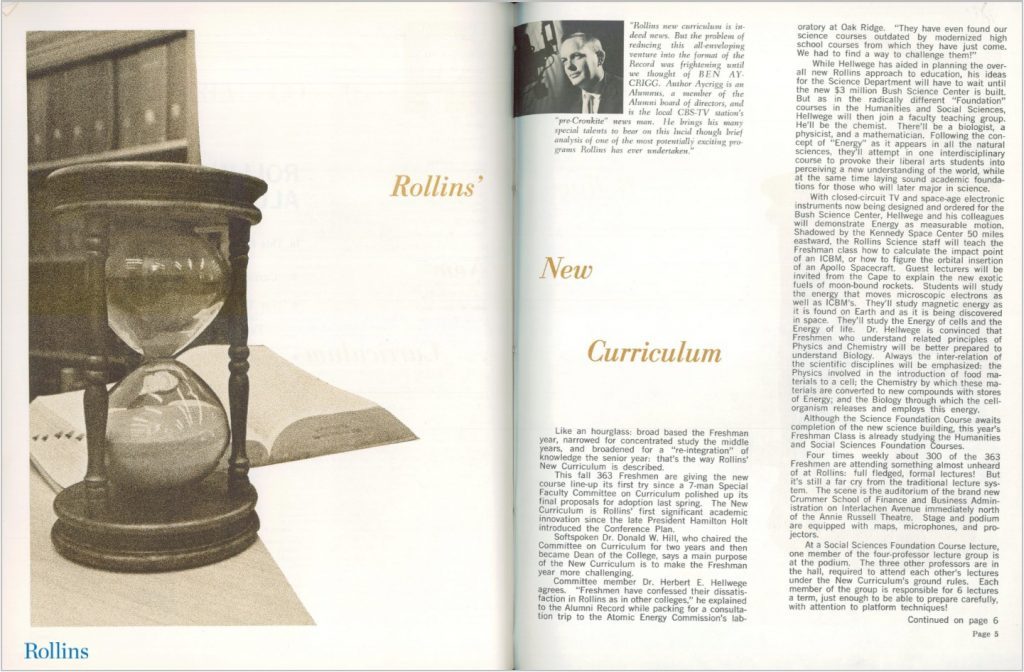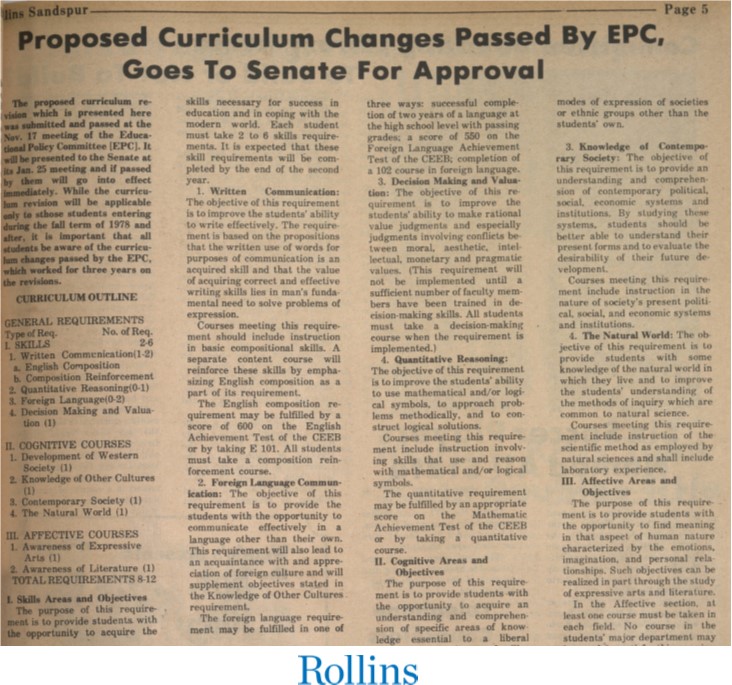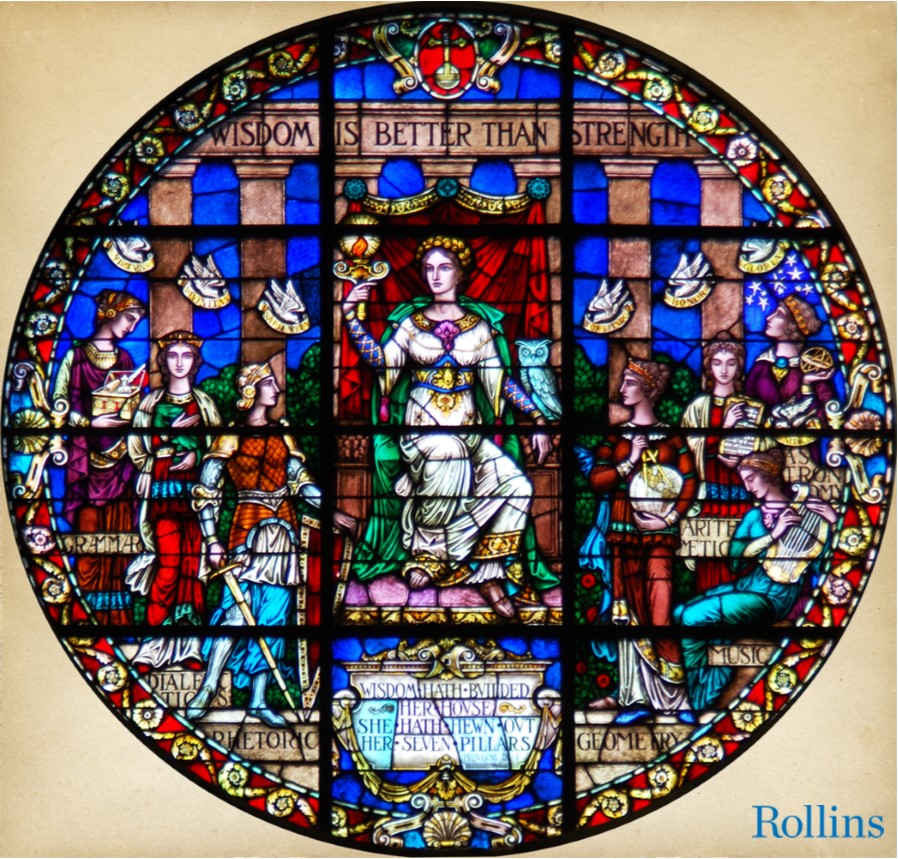
Alexander W. Weddell Professor Emeritus of American History and College Historian
The Archives is happy to share this guest blog post from Dr. Jack Lane ’06H. This article is adapted from Dr. Lane’s latest book, Rollins College Centennial History: A Story of Perseverance, 1885-1985. It is the first in a two-part series on the evolution of the Rollins curriculum.
________________________________________________________
President Edward P. Hooker (front row, on the right) and the faculty of Rollins College on the porch of Pinehurst Cottage, 1891
When the Congregationalists founded Rollins College in 1885, they had no problem creating a course of study, because they had access to a ready-made one called the Classical Curriculum. Inherited from Europe and modified to fit the American condition and needs, the Classical Curriculum became by mid-nineteenth century the keystone of a collegiate education. Intended to do more than impart knowledge, it sought also to build character and to produce a cultured, refined person. These goals could be achieved, it was argued, through studies in Greek and Latin grammar and literature. These subjects had the added value, according to the curriculum’s proponents, of sharpening the students’ mental faculties. The famous Yale Report of 1828 declared that these fields of study provided “the discipline and the furniture of the mind; expanding its power, and storing it with knowledge. A commanding object, therefore, in a collegiate course should be to call into daily and vigorous exercise the faculties of the student” (Rudolph 1962, 88).
In American colleges, natural philosophy (physics and chemistry), natural history (geology and biology), and mathematics were added later in the century. The senior course on moral philosophy, usually taught by the college’s president, sought to draw together four years of learning and to prepare graduates for a worthy life.
The Classical Curriculum for Rollins freshmen, from the 1890-1891 College catalogue
Recitation, a pedagogy that required students to memorize and then to recite passages from an assigned text, represented the standard teaching method. The philosophical rationale behind this pedagogical method known as faculty psychology argued that the mind was a muscle requiring daily exercise, and that intellectual acumen came from training in memorization, habit, routine, and hard work. As one contemporary stated, recitation and study of the classics “improve the memory, strengthen the judgment, refine the taste, give discrimination and confer habits of attention, reasoning and analysis–in short, they exercise and cultivate all the intellectual powers” (Lane 1987).
In the first half of the nineteenth century, such beliefs solidified into orthodoxy and became firmly cemented into the college curriculum. No reputable college would dare deviate from the norm historically set by Ivy League colleges. Yale particularly became a kind of universal model. When many colleges (including Rollins) advertised that they were built on the Yale model, they meant that they had reproduced Yale’s classical curriculum and were emphasizing the recitation method. The advantage of this imitative process was that it produced unity and continuity in American higher education, a unity that lasted throughout most of the nineteenth century. It was also problematic: it created a static institution in the midst of a society undergoing dynamic change.
A society involved in modern industrialization, urbanization, and professionalization had difficulty seeing the relevancy of the Classical Curriculum, with its emphasis on ancient (dead) languages and literature and its rigidly prescribed courses. Practical American society began pressuring institutions of higher learning to offer courses such as English, history, politics, and applied sciences, that seemed more related to real life. Emerging state universities responded to this pressure by offering a greater variety of courses and also granting a variety of degrees, from Bachelor of Science to Bachelor of Agriculture. In time, liberal arts colleges found it impossible to withstand the pressures to make changes.
In the mid-1890s, a newly appointed Rollins president, George Morgan Ward, responded to these pressures by not just instituting reforms, but by completely transforming the curriculum. He abandoned the Classical Curriculum altogether. In his first commencement address, he informed the college community that “Life is too diverse in its varied interests for any person to have a working knowledge of sufficient breadth to enable him to be of real assistance to the world in more than one department.” After providing a broad foundation, he proclaimed, colleges “ought to give students the opportunity to become specialists in a special field of endeavor.”
President George Morgan Ward, from The Sandspur, May 1896
Ward’s remarks clearly foreshadowed a major change in the course of study, because under no circumstances could the prescribed Classical Curriculum embody such views. After working with a group of faculty in the summer of 1896, Ward announced a major curriculum revision for the next academic year. It proposed two fundamental changes. In place of the fixed Classical Curriculum that required all students to take the same course of study, the revision outlined in the college catalogue introduced the concept of electives, a program that allowed “pupils to choose their own courses in order that their education may be designed to their tastes and chosen vocations.” Thus, whereas the Classical Curriculum had divided the course of study according to class year and prescribed the courses students would take in each of the years, the new curriculum separated the course of study into four divisions. These new categories included General Courses, Special Groups, Thesis, and Additional Electives. General Courses included the fields of English, moral and political sciences, and modern languages. Students would be required to take at least one course in each of the areas, but since several courses were offered in each area, they were given the opportunity to exercise the elective principle. The same options were open in the Special Groups, where students could select one of the eight courses and devote an entire year (spread over four years) to the subject. Another requirement included a written thesis “on some subject connected with the Special Group and embodying the results of original investigation.” As a way of further emphasizing freedom of choice, the students were allowed to select almost one-third of their courses as electives with “no restrictions whatsoever on the selection.” Entrance requirements, revised drastically to coincide with the new curriculum, replaced a long list of Greek and Latin works with new requirements that emphasized English, modern languages, science, and history.
The revised curriculum, 1897
The elective curriculum instituted by Ward and the faculty at the end of the nineteenth century formed the basis for the Rollins curriculum for the next two decades. The curriculum remained virtually unchanged until Hamilton Holt assumed the presidency. Within weeks of his arrival in 1925, Holt began leading the college into a second major transformation that encompassed the college’s entire physical, social, and academic way of life. Academic reforms were at the core of these changes, because Holt came with previously formed innovative ideas. He first sought to re-envision the prevailing pedagogical methods of lecture and recitation. In his early years at Rollins, he told anyone who would listen that the lecture system (which had replaced recitation) was the “worst pedagogical method ever devised for imparting knowledge, because though a lecturer may serve to inspire a student who has some familiarity with the subject, it invariably mostly discloses the personality–good or bad–of the lecturer” (Holt 1926). “The assumption,” Holt argued, “that knowledge may be poured into another and assimilated without the other going through something of the same process of preparation is perhaps the greatest fallacy of modern pedagogical psychology” (Anonymous 1927).
Hamilton Holt, from the 1926 Tomokan yearbook
Working with his Dean of the College during the summer of 1926, Holt produced what he called the Conference Plan of classroom teaching. Intended to mimic an apprentice workshop, it established two-hour classes meeting three times a week and with a supervised fourth period, 3:00-5:00, devoted to varied activities such as field trips, laboratory work, or physical education classes. In the two-hour period, students would proceed at their own paces. In theory, more mature, intelligently capable students would be given the freedom and opportunity to explore more complex material, while others might require more supervision from the professor. As stated in the first catalogue, ideally the plan promised “the free exchange of thought between pupil and teacher in personal conference during which the student is helped over difficulties, shown how to study, and given an illustration of a scholarly attitude for knowledge.” The Conference Plan aimed to socialize education by bringing the professor and the student into a kind of partnership, thus making that relationship as important as the subject matter. In this sense, both teacher and student would actively participate in the educational process.
Professor Edwin Grover and his students, seated together at an oval table, in a classroom designed for the new Conference Plan of education (1926-1927)
Apparently on his own, Holt had arrived at an insight that formed the foundation for a new American educational movement, termed Progressive Education. Led by educational philosopher John Dewey (who would later guide Rollins in a curriculum revision), progressive educators stressed a humanized system that placed the student at the center of the educational process. Within a short time after assuming the presidency of Rollins, Holt became a full convert to this Progressive Education Movement, a decision made easier because he had earlier worked out its basic principles himself.
Earlier Ward reforms had unshackled the students from the prescribed classical curriculum and replaced it with the elective system, which allowed students some choices in their course of study. Holt’s pedagogical reforms encouraged students, facilitated by professors, to assume responsibility for their own learning. Now the college was ready to create a curriculum that matched the premises of the new pedagogy. When Holt and the faculty began to perceive the similarities between the Conference Plan and Progressive Education theory, they moved swiftly to place the college firmly in the progressive curricular reform tradition.
In 1930, Holt contributed an article entitled “The Rollins Idea” to The Nation’s popular series on educational experiments in higher education, where he showed how thoroughly the college community had embraced progressive ideas. At Rollins, Holt declared,
“We hold the belief that the individual student’s growth and development are the all-important things, and that to justify itself, every course, by its subject matter and manner of being taught, must deepen and broaden the student’s understanding of life and enable him to adjust himself more quickly and more effectively to the world in which he lives. This theory assumes an approximation of college life to normal living as well as a correlation of subjects to be studied. On this premise, we have shifted our emphasis and our forms of responsibility from the faculty and administration to the students. We find that because young people really accept responsibility willingly and carry it well, because they like being treated as adult, reasonable beings, they seem to lose, if they have it on entrance, the average student’s resistance to things academic. They learn to recognize education for the thing we believe it should be: a joint adventure and a joint quest” (Holt 1930).
John Dewey could not have better articulated his own theory of education.
Hamilton Holt’s article, “The Rollins Idea”
Holt closed his article suggesting the college was embarking on a major curriculum revision. For that purpose, he said, he had called a curriculum conference composed of leading national educators to advise the college on its revision. Holt proudly announced that he had persuaded progressive education’s leading theoretician, Professor John Dewey, to head the conference. As Holt promised, John Dewey chaired a conference in January 1931 that included several national progressive educational luminaries. The outcome was a document that provided a progressive theory of collegiate education and issued a set of guidelines for a progressive college curriculum.
John Dewey and the Report of the 1931 Curriculum Conference. (Photo of John Dewey: Underwood & Underwood [Public domain], via Wikimedia Commons)
Armed with this theory and these guidelines for constructing a progressive curriculum, the faculty passed a new curriculum in May 1931. The new course of study, called “Individualization in Education,” now placed students’ interests and individual differences in the foreground. Rather than the usual classifications of Freshmen through Seniors, students became members of the Lower and Upper Divisions. The catalogue explained that the revised course of study would “substitute learning for instruction,” would “encourage intellectual curiosity and enthusiasm,” and most importantly, would “develop the individual in the manner best suited to him.” Individualization thus became the centerpiece of the new curriculum. It would be achieved by admission requirements that emphasized individual character and student achievement in secondary school rather than some fixed number of units studied; by assigning students advisers who would guide and nurture them through their education; and by allowing students, with faculty advice, to pursue personal interests, especially in the Upper Division. Even in the Lower Division, where some courses were required, the curriculum allowed students considerable flexibility in devising a plan to meet requirements for entrance into the Upper Division. In further recognition of individual differences, the curriculum placed no time limit on the completion of work within either division. Finally, the college determined a student’s qualifications for graduation not by the number of course credits accrued, but by the student’s “accomplishments, intellectual ability and degree of application.”
Illustration from “Helping Students Use Their Minds,” an essay in the College booklet An Experiment That Has Proved Itself, 1939.
Starting with the freshman class of 1931, the college community placed itself at the cutting edge of small colleges that had embarked on new and innovative progressive experiments in higher education. With its individualized curriculum, the college could (and most loudly did) proclaim that it was in the forefront of progressive higher education, basking proudly in its national reputation of an institution eager to experiment with fresh educational ideas. An immediate benefit of the new curriculum, however, was the intellectual ferment that engulfed the campus during the early thirties. The entire college community was involved for over a year in an intensive debate over educational ideas. This discourse itself was a significant learning experience at Rollins, and as it turned out, it precipitated an academic dialogue that would become a lasting part of the Rollins tradition.
Even though future generations would find it necessary to revise the curriculum to meet changing conditions, the theory and ideas informing the progressive educational tradition initiated in the 1930s remained consistent. The first post-Holt revisions came in the 1960s with a new course of study called the “Hour-Glass Curriculum.” The new plan’s purpose clearly connected with the Rollins progressive education tradition: inherent in the new curriculum, the 1966-67 catalogue stated, was “the philosophy that each student should move from a passive absorption of knowledge to self-motivated learning, and that each student must gain a perspective which can relate his own special field to much wider areas of human knowledge.” In a Sandspur article, the committee further elaborated on the new curriculum’s connection to the college’s past:
“Education must keep pace with the fast-changing times. The new format will cope with today’s ‘information explosion’ by giving a solid background for changing concepts which graduates will meet throughout their lives. It will prevent spottily-educated graduates. It will overcome the danger of training specialists with too narrow a vision for the good of themselves or their society. Rollins is re-affirming and strengthening its identity as a liberal arts college. The main idea is to stress integration in fields of knowledge instead of individual disciplines within a field. It makes sure that graduates go out with a perspective of the whole . . ” (Anonymous 1966).
An article introducing the Hour-Glass Curriculum from the Rollins College Alumni Record, October 1966
The “Hour-Glass” metaphor simulated the student’s educational journey. Broad and required team-taught “Foundation Courses” occupied the freshman year; required and elective courses, the sophomore year; concentration on a field of interest, the junior year; and, by utilizing both broad study and individual interest, seniors would be required to relate their special fields to “wider areas of human knowledge.” An eight-week winter term allowed students to become acclimated to individual and independent study and gave the faculty the opportunity to introduce topics not ordinarily taught in the regular terms.
The second post-Holt curriculum revision came in 1978. This curriculum was based on a new and innovative approach to learning called “Bloom’s Taxonomy,” a system of hierarchical domains that replicated students’ learning styles. This approach identified three areas of student cumulative learning: 1) the acquisition of skills “necessary for success in education and coping with the modern world” (fields included Writing, Foreign Language, and Quantitative Reasoning); 2) Cognitive Learning, which enabled “students to acquire a comprehension of specific areas of knowledge essential to a liberal education and to become familiar with the methods of inquiry in each of these areas” (fields included Knowledge of Other Cultures, Knowledge of American Society, and Knowledge of the Natural World); 3) Affective Learning, which enabled “students to find meaning in emotions, imagination, empathy and interpersonal relations” (fields included Expressive Arts and Literature).
The proposed new curriculum outlined in The Sandspur, January 20, 1978
The new curriculum was based on the implied theory that over four years of study, students would gradually proceed, through a cumulative development, from basic skills to an acquisition of methods of analysis and discrimination; and finally, by attaining the ability to evaluate their previous learning, students would be equipped to form their own philosophy of life. Cross-discipline requirements in writing and valuation became an essential part of the curriculum. Whatever the virtues and/or shortcomings of the taxonomy approach, it was clearly a response to a society becoming increasingly incorporated and professional. It would serve the college for the next two decades.
CONCLUSIONS
The history of Rollins’ curriculum reveals how the college consistently revised its courses of study to reflect changes in American society. The supporters of the unified Classical Curriculum assumed a unity of purpose in this society, as well a belief that its curriculum, along with paternalistic Christian influences, would help shape a student’s moral character. The elective system of the 1890s reflected the growing diversity of purposes in American life. The creators of this curriculum emphasized the need to prepare students for some unspecified way of life and, except for a continuing belief in Christian influences, remained silent on just how the elective curriculum would help shape a student’s character.
The title of the 1930s progressive curriculum, “Individualization in Education,” reveals how much the American society had come to embrace a diversity of purposes. Within a general framework, students could create their own courses of study. This left them free to determine their own purposes in life. The taxonomy curriculum of the 1980s took for granted the self-determination of each student. It aimed instead to arm students with the skills of critical thinking that would make them better equipped to decide their own purposes in life.
Thus, one of the salient characteristics of the historically evolving Rollins curriculum has been the community’s willingness to respond to the changing conditions of American society by reinterpreting the meaning and purposes of a liberal education. This traditional readiness to meet challenges gives Rollins College its most distinctive characteristics.
The Rose Window of Knowles Memorial Chapel, depicting the seven liberal arts (Grammar, Dialectics, Rhetoric, Geometry, Music, Arithmetic, and Astronomy)
SOURCES CONSULTED
Anonymous. 1927. “The Two-Hour Conference Plan.” Printed by The Rollins Press.
Anonymous. 1966. “New Curriculum Instituted.” The Rollins Sandspur 72, no. 11: 1.
“Changes at Rollins College.” Supplement to the Catalogue of 1896.
Holt, Hamilton. 1926. “The Rollins College Ideal.” Rollins College Bulletin XXII, no. 5: 3-22.
Holt, Hamilton. 1930. “On the College Frontier: The Rollins Idea.” The Nation 131, no. 3405: 322-373.
Lane, Jack C. 1987. “The Yale Report of 1828 and Liberal Education.” History of Education Journal (Fall): 325-338.
Rudolph, Frederick. 1962. The American College and University. New York: Knopf.

